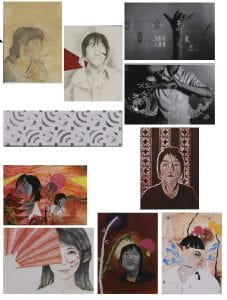This is a portfolio exercise I did for Art L1 and I will be explaining why I have arranged them like in this picture.
Sorting pictures on a board is like giving it a beginning and an end. I started with something that introduces what will be seen in the next drawings, like a subject. Then, I placed something impressive at the end, a picture the seems to be a conclusion for the series of drawings. The further we get with the series of drawings, there’s a gradual thing that differentiates the drawings from the previous. This change is the graduality of building up to the impressive drawing at the end I was talking about.
As I was sorting these pictures, I tried halving the drawings. One side are drawings with little to no color, and the drawings that were colored had their side. Though you can see a mistake was made when I was trying to half the drawings. On the bottom left, we see a picture with some color, but should’ve belonged to the upper half of the arrangement.
There are many other ways to arrange a series of drawings, such as arranging them from oldest drawing to earliest to compare the improvement from each drawing. But this isn’t always done because an entire series of drawings could be about a theme. This means that some drawings on a board may or may not be arranged from oldest to latest because the arrangement is following a certain theme.



